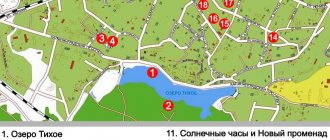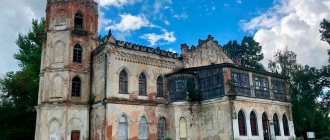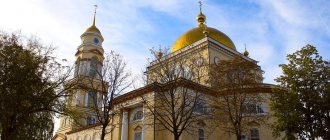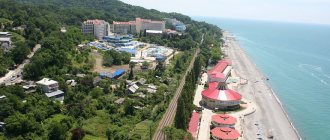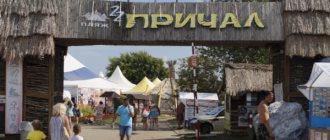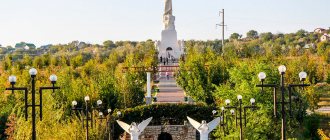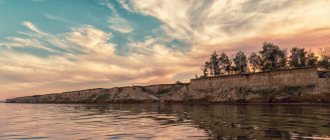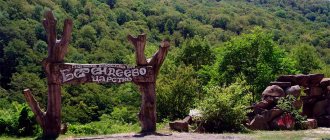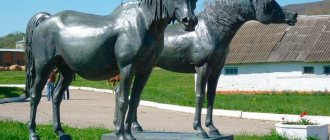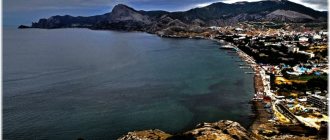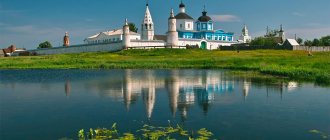On the southern coast of Crimea, not far from Alupka, there is a resort village with the unusual name Simeiz. It is believed that translated from Greek it means “flags”. History is silent about why the settlement received such a name. The modern flag and coat of arms depict Mount Cat, Rock Diva and the family coat of arms of the Maltsovs, through whose efforts Simeiz became one of the best resorts on the southern coast.
Simeiz village
In the paws of a cat
Simeiz is located on the southern slope of the Crimean Mountains at the foot of Mount Koshka. Its name has nothing to do with the furry pet. The Crimean Tatars called the mountain Kosh-Kaya, which means “double rock”. The mountain really has two peaks. Later the name was transformed into "Cat". To be fair, it is worth noting that from a distance the mountain really does resemble a lying cat. Its height is 254 meters.
Mountains in the vicinity of Simeiz
Simeiz is a typical seaside climatic resort for Crimea. Local residents have a purely theoretical idea of the harsh snowy winter. The air temperature in February ranges from +4 to +8 degrees. The average temperature in August is plus 26 degrees. In summer, the water in the sea warms up to +22-27 degrees. You can swim from May to October. On average, 500 millimeters of precipitation falls per year, and humidity is 70%.
The village is located on a narrow coastal strip at an altitude of 60 meters above sea level. The former village received settlement status in 1929. At the beginning of the last century, about 600 people lived here. The population increased sharply to 4,500 people in the late 1930s. Now the village has 2,700 residents. In the summer, this figure increases many times due to vacationers. The local population is engaged in their maintenance.
Where is the village
Simeiz is a village with many attractions, located on the southern coast of the peninsula, 25 km west of Yalta, near the city of Alupka. Its area is about 3 square meters. km, the population is 4 thousand people.
Exact geographical coordinates: 44024'00“N. 33059'25” E.
You can get here using the following routes:
- By plane to Simferopol airport. Flights depart from Moscow Sheremetyevo and Domodedovo airports, from St. Petersburg and other Russian cities.
- For residents of the Krasnodar Territory and surrounding areas, it is more convenient to travel through the Crimean Bridge to Kerch (by bus).
- The Kerch ferry service operates; those wishing to get to Crimea can use its services.
The railway and bus routes through Ukraine are currently closed: only Ukrainian citizens have the right to cross the Crimean-Ukrainian border at the Chongar and Kalanchak checkpoints.
Simeiz is one of the most popular resorts in Crimea, so it’s easy to get to the village from any major city on the peninsula.
For example, you can choose the following routes:
- from the bus station at the railway station in Simferopol by bus to Simeiz. During the holiday season, buses run twice an hour. This is the easiest option for those arriving by plane;
You can get to Simeiz from the Simferopol bus station - by bus or trolleybus from Simferopol to Yalta, then by buses No. 42,107 or 115 to Simeiz (every 20 minutes);
- by bus or train from Kerch to Simferopol, then from any bus station through Yalta to Simeiz (for those arriving via the Crimean Bridge);
- by bus or train to Sevastopol, then by bus to Simeiz (for tourists who want to see Sevastopol along the way);
- owners of their own vehicles can try the route along the coast: Kerch - Feodosia - Sudak - Alushta - Yalta - Alupka - Simeiz, mountainous sections of the road, replete with sharp turns, sharp descents and ascents, are a serious test for the driver and passengers: this must be taken into account;
- Taxi or private transportation services: those interested are waiting at the airport, at the railway station, at all bus stations in the capital of Crimea and other cities of the peninsula.
From Taurians to Maltsovs
Not far from Simeiz, archaeologists discovered a site of ancient people who lived here thousands and thousands of years ago. What kind of people they were is unknown. The first mentions in written sources concern the Tauri, who lived on the coast much later - from the 6th century BC to the 1st century AD. It is believed that it was the Tauri who left behind the mysterious dolmens. They built a fortification on Mount Cat, and at the foot they built a cemetery, which has 95 graves.
View from Mount Cat
At the beginning of the first millennium, a continuous change of owners of coastal lands began. The Taurians were replaced by the Byzantines. Most likely, it was during this period that the former Taurus settlement began to be called Sembos. Then the Genoese came to these lands. In the Middle Ages they were replaced by the Ottomans. At that time, about 30 families lived in the village. In 1783, Crimea became Russian. During this period, the replacement of Sembos with Simeiz took place. At least in Russian documents the village appears under a new name.
From time immemorial, the inhabitants of Simeiz were engaged in viticulture and fruit cultivation. The situation changed dramatically when brothers Nikolai and Ivan Maltsov became the owners of the land. In 1900, they decided to hand over part of the territory for the construction of summer cottages and boarding houses. This is how the resort village of New Simeiz was born. It soon became an aristocratic resort with a large park and luxurious villas. Some of them have survived to this day. In 1912, Nicholas II and his family came to Simeiz. He met with the owners of the resort.
Coat of arms of Simeiz
Most medical institutions and rest homes were opened in the 50s. Among them are the sanatoriums named after the XXII Congress of the CPSU (now Simeiz), Lenin (Youth), Moscow, Blue Bay and others. The composer Sergei Rachmaninov, writers Konstantin Paustovsky and Leo Tolstoy, the founder of Harbin Nikolai Sviyagin and other famous people lived in the village at different times.
Milyutinsky Park and boundary pillar
The territory between Alupka and Simeiz, where Pan Medvedchuk’s , is the Bobrov children’s tuberculosis sanatorium and Milyutinsky Park. It once belonged to the Minister of War of Russia under Alexander II, Dmitry Alekseevich Milyutin.
Even before the creation of the empire of the Maltsov brothers, the Milyutin estate with a wonderful park and vineyards covering almost 50 acres had already been built on the territory of Simeiz.
Today little remains of its former greatness. The park is a pitiful sight, as is the estate itself.
A landmark for examining the remains of the estate can be the boundary post, which is located on Bobrova Street. Once upon a time it served as the border between the Milyutin estate and the lands of the Vorontsovs.
The border with the Maltsovs ran along a stream, which is located near the Simeiz wastewater treatment plant.
Active relaxation
There are several beach holiday spots in Simeiz. On the Central City Beach there is a rental of sun loungers, free canopies, showers, changing cabins, and toilets. Vacationers are offered active entertainment - banana boat rides, jet skis, catamarans. The disadvantage of this beach is that there are too many people. In this regard, Boathouse Beach is more comfortable. It is small in size, but it is not crowded. It got its name from the boathouses - guest houses that stand near the beach.
The beach “Naryshkinskie stones” is popularly called “Bashmak”. It received its official name in honor of Countess Naryshkina, who had an estate in Simeiz. Due to the slippery boulders, entering the water is not very convenient. Scuba diving enthusiasts come here willingly. Within the village there are also wild beaches “Primorye” and “Semashko”. They are distinguished by their privacy. The beach near the Ai-Panda spring is very popular. There is a shallow bay where children can swim in complete safety.
There are several beach holiday spots in Simeiz
The most popular is the beach near the Diva rock. Changing rooms, toilets, catamarans, slides, water attractions - all these amenities are available. In the evening there is a disco right on the beach. There is a cafe and a diving club. Near Mount Koshka on the Blue Bay side there is the largest nudist beach in Crimea. All beaches in Simeiz are small-pebble. You can relax on them for free.
There is a water park "Blue Bay" in the village. There are eight slides here. The names “Black Hole”, “Turn”, “Tsunami”, “Kamikaze” - speak for themselves. There are six pools, including Wave and Cascade. There is a large children's area with water activities. Fans of active recreation are offered SUP boards, Nordic walking equipment, beach volleyball, tennis, darts and cycling. The water park has a hotel and car camping.
There is a water park in Simeiz
There are open-air fitness machines in the resort park above Cypress Alley. Climbers and mountaineers willingly come to Simeiz to conquer Mount Cat and the Swan Wing rock. There are several hiking trails in the vicinity of the village. The Jewish trail is an ancient road that goes from the Ai-Petri plateau to the Alupka region. Its length is 8 kilometers. The climb to Ai-Petri through Shaan-Kaya is popular among tourists.
Simeiz Park
The park in Simeiz is famous for its cypress alley, in the center of which there are copies of sculptures of ancient Greek gods.
In general, Simeiz Park is excellent in everything - a large juniper grove, collections of all kinds of trees and shrubs, flower beds, neat paths and fabulous lanterns.
You can go out to the observation deck, equipped in the Greek style, and enjoy the mountain scenery, or relax in a wooden gazebo, among fragrant evergreens.
There was also a monument to Lenin . Only here he looks more like Ilya Muromets than a grandfather with a beard.
The central alley - Lenin Avenue, divides the park into 2 parts:
- upper one with the villa buildings of the “ Red Mayak ” sanatorium and a children’s playground in the shade
- the lower one is large, adjacent with stairs to the embankment.
Walking in the lower part is incomparably more beautiful. In addition, you can find interesting views with arches and blooming splendor.
But for mothers with strollers, the walking area will be limited by ubiquitous steps.
The only things better than mountains are mountains
Since 1984, Mount Koshka has the status of a natural monument of national significance. It is located between the villages of Simeiz and Blue Bay. On the northeastern slope, archaeologists discovered the ruins of a settlement that dates back to the 5th millennium BC. This means that people lived here 7 thousand years ago! Near the mountain there is a grave monument, which is the largest in Crimea. At the top of Koshka, the remains of the Limen-Isar fortifications have been preserved. They were built several thousand years ago.
Mount Cat is composed of limestone and has a height of 254 meters. Elephants are almost devoid of vegetation. There are cliffs and karst growths on them. There is a stone ridge up to seven meters high. It is dissected by a crevice overgrown with bushes and trees. The flora is represented by tree-like juniper, blunt-leaved pistachio, hornbeam, fluffy oak and Crimean pine. In scientific language, all this is called a landscape reserve.
The isolated rocks that separate Mount Cat from the sea deserve attention. The rock that stands further into the sea is called Diva. Its height is 51 meters. It was once part of the Crimean mountain range. The rock is composed of limestone. The steep southern slope has long been favored by rock climbers. A hundred years ago, a staircase was built on the gentle northern slope, and an observation deck was installed at the top. The Diva and Mount Cat are depicted on the coat of arms of Simeiz.
The decoration is free-standing rocks in the sea
The name Diva is believed to be derived from the ancient Indo-Aryan word "diva", meaning "god". Or from “jiva” - soul. From a certain angle, the rock resembles the silhouette profile of a girl. According to legend, this was a woman who was turned into stone for her evil deeds. Nevertheless, the rock is very picturesque and has served as a subject for many artists. The famous Russian marine painter Lev Lagorio depicted her in the painting “Rocks Monk and Diva” in 1890.
The second rock is called Panea. She is located between Cat and Diva. The name comes from the Greek word “panaya” - “holy”. The height of the rock reaches 70 meters. The northwestern and western slopes are almost vertical cliffs. They go steeply into the sea and are therefore inaccessible. But in ancient times there was even a road built along the eastern slope. Its traces leading to horizontal platforms have been preserved.
Archaeological finds on Panea indicate that the Tauri lived on the mountain. This is evidenced by fragments of characteristic ceramics. After the Taurians there was a monastery with residential buildings and fortifications. Scientists date it back to the 10th century. Then the Genoese settled here, leaving behind the remains of fortress towers and walls. The fortress operated in the 15th century. Panea is a real archaeological layer cake.
Archaeological finds indicate that in ancient times Tauris lived in these places
Alas, all the buildings were heavily damaged by a strong earthquake that occurred in 1927. Then the entire southern slope of Mount Cat was destroyed. The same blow of the elements almost to the ground demolished the Monk rock, which stuck out of the sea between Diva and Panea. The destruction of the rock was completed by a severe storm in 1931.
Panea Rock
Above the beach near Diva rises another interesting place in Simeiz - the Panea rock. Once upon a time, on its slopes there was a small settlement, a fortress, several temples... Now only the remains of defensive walls overgrown with juniper forest remain. From the viewing platforms at the foot there is an excellent view of the beach, Diva, and Cat.
If you climb to the top, the panorama that opens will be as beautiful as the one from Diva. You'll have to walk along the paths and conquer a couple of boulders. There is no observation deck at the top.
More information about the Panea rock:
- Fortress at Panea
- Panea Photos
Architectural kaleidoscope
At the beginning of the last century, the Maltsov brothers founded a resort village in Simeiz. They approached the matter thoroughly, inviting famous architects. Each building was carried out according to an individual project. They built a bathhouse, a swimming pool, a restaurant, a pharmacy, a post office, and a people's house. Particular attention was paid to three-story villas. Each had its own name - “Miro-mare”, “Khaial”, “Elvira”. Many buildings have survived to this day and are decorations of the resort.
The Villa “Ksenia”, built in the Northern Art Nouveau style at the beginning of the 20th century, deserves special attention. The unusual building included two residential buildings with 28 rooms with a maid's room, a living room, an observation deck, a restaurant and even a store. The idea of the “Scottish chalet” belongs to the royal palace architect Nikolai Krasnov. The villa is located at the beginning of a cypress alley and is decorated with sculptures.
Villa “Chrysolite” (Villa Lansere in Simeiz) L.V. Rheinberg, photo 1914
Villa “Dream” is considered another calling card. Its tower, reminiscent of a minaret, can be seen from afar. The spectacular building in the pseudo-Moorish style was erected at the beginning of the 20th century. It is assumed that the luxurious dacha was built for Vaclav Wilezhinsky, the manager of a Polish bank. No less impressive is the Neo-Renaissance Villa Divo. It looks like a European castle. The villas “Khayal”, “Big Bogdan” and Subbotina’s dacha in the Art Nouveau style with elements of pseudo-Byzantine style have been preserved.
“Hailal” was built as an estate with a dozen rooms and a library. Before the revolution, its last owner was a gentleman named Bender! Villa Sviyagina is very beautiful, which is a real palace in the neoclassical style. Many former villas are located on the territory of the Yunost sanatorium. In particular, this is the Chrysolite villa in the early modern style. Simeiz amazes with its architectural diversity.
The observatory on Mount Koshka is considered a landmark of Simeiz
The Simeiz Observatory on Mount Koshka is considered a unique attraction. It was here that the world's first station was located from which lunar spacecraft were controlled. Here the first photographs of the far side of the Moon were taken. The first asteroid discovered by Russian astronomers was named Simeiz. The observatory operates a laser station for observing artificial earth satellites.
Best hotels in Simeiz
Related materials:
- 33 attractions of Bakhchisaray that are worth visiting
- 29 best attractions in Orel,…
- 40 attractions in Limassol that are worth seeing
- 28 best sights of Uglich,…
- 25 sights of Olenevka that are worth seeing
- 43 attractions of Adler that are worth seeing
- 36 sights of Pyatigorsk,…
- 30 attractions of Lazarevsky that…
- 38 sights of Kaluga that are worth seeing
Did you like the article? Share with friends:
Crimean Hollywood
Rock Diva served as a natural backdrop for filming episodes of the science fiction film “Amphibian Man” based on the novel of the same name by Alexander Belyaev. Directors Vladimir Chebotarev and Gennady Kazansky shot the film in the 60s. At first there were plans to do this in the Sargasso Sea in the Atlantic, but there was only enough money for the Black Sea. The problem was that the Black Sea has extremely scarce living creatures. I had to do a combined shooting using an aquarium with fish.
The diva also appeared in the detective film by Stanislav Govorukhin “Ten Little Indians” based on the novel of the same name by Agatha Christie. According to the script, at the very beginning of the film, a boat with guests leaves the pier in Gurzuf, sails past an unnamed rock in the open sea, and then moored to the Diva rock. The stairs leading to the top of the cliff were useful for filming. Guests supposedly used it to ascend to the house on the island.
These places appeared in many Soviet films
The action of the musical film comedy “Chapiteau Show” takes place in Simeiz. The film directed by Sergei Lobanov starred actors Pyotr Mamonov, Vera Strokova, Alexey Podolsky and others. The main characters Princess Vera and the Cyberwander communicate against the backdrop of the Simeiz beach and bus station. Another meeting of the heroes takes place in the Simeiz cafe, and the banquet takes place in the restaurant of the Simeiz hotel. A pedestrian street can also be seen in the film. The film "Tentee Show" was released in 2012.
Episodes of the comedy “The Personal Life of the Queen,” which was released in 1993, were filmed on the Semeiz beach. It involves such stars as Alexander Pankratov-Cherny, Natalya Gundareva and Leonid Kuravlev. An episode of the film “New Adventures of the Elusive” was filmed on the pier. In it, Yashka the Gypsy jumps from the pier. But the real jump was performed by an understudy from local residents. But he was no longer jumping from the pier, but from the Diva cliff.
When, in 2005, a typical southern town was needed for the Russian-French comedy “Poor Relatives,” director Pavel Lungin chose Simeiz. And the territory of the Simeiz Astrophysical Observatory temporarily became the Wizard’s Island in the children’s film “The Secret of the Iron Door.” The wizard's house was built on the coast of the Blue Bay near Mount Cat.
Simeiz can be called “Crimean Hollywood”
In 1985, an episode of the military drama “The Drummer’s Tale” directed by Eduard Dmitriev was filmed in Simeiz. Starring Lev Durov and Semyon Farada. The Simeiz film epic ends with a short film called “The Last King of the Simeiz Beach.”
House-Museum of A.P. Chekhov
- Anton Pavlovich spent the last years of his life in this house
- A garden was laid out on the site and a house was built according to the design of the architect L. N. Shapovalov
- It was here that such famous works as the story “The Lady with the Dog”, the plays “Three Sisters” and “The Cherry Orchard”, as well as the story “In the Ravine” and the stories “The Bishop”, “At Christmastide” and “The Bride” were written.
When the writer moved to Yalta, a house with an outbuilding was built on Kirov Street in 1898. Chekhov moved into the house only in 1899. The museum was opened after restoration work in 1980. The collection represents the original handwritten works of the author: “The Lady with the Dog”, “My Life”, “On the High Road”, “Three Sisters”. Here you can also see the author’s personal belongings and antique furniture. The pearl among the exhibits is the philatelic collection of Chekhov stamps with rare specimens from foreign countries.
Dreamwood
https://dreamwoodpark.com/
- Thus, during the construction of the park’s attractions, heavy-duty modern materials, mainly fiberglass, were used, all attractions are regularly checked for serviceability
- The park complex is divided into a number of thematic departments, which makes your stay varied and not boring.
- Some objects of the Dreamwood amusement park are quite extreme
A children's park was opened on the territory of the Mriya Hotel. Dreamwood is famous for its extraordinary children's attractions and strict safety rules, the neglect of which results in expulsion from the park. Miracle Park is divided into play areas for children of different ages and abilities. In the center of the park there are main play areas where you can leave your child under the supervision of a counselor. The marine and mountain world departments are also worth a visit.
Cable car Miskhor - Ai-Petri
- The road has been under construction since 1967
- The road opened in March 1988
- The passenger cabin covers the journey in 15 minutes
The cable car from Miskhor to Ai-Petri took more than 20 years to build. The length of the path is almost 3 km. There are 3 stops: Miskhor, Sosnovy Bor and mountains. The uniqueness of the cableway is the steep climb between Sosnovy Bor and Ai-Petri. The ride along the rope takes 15-20 minutes, but during this time the audience will see all the beauty and uniqueness of the surrounding nature.
